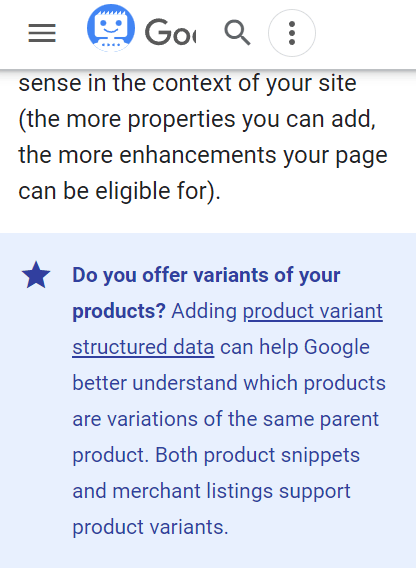Big Change To Google’s Product Structured Data Page via @sejournal, @martinibuster
Google completely revamped their +6,000 word Product Structured Data documentation into three topically focused pages The post Big Change To Google’s Product Structured Data Page appeared first on Search Engine Journal.

Google revamped their product structured data documentation by splitting up one comprehensive page into three pages that are more closely focused on their topics, providing an example of how to rewrite a page that’s too big and turn it into multiple topically relevant webpages.
Google Product Structured Data
Product structured data is essential for ecommerce and product review websites because they help make them eligible for rich result listings in Google’s search engine results pages (SERPs). When correctly deployed, the product structured data can make a significant contribution to the amount of traffic received by a website and earnings.
Google’s restructuring of the official documentation gives the ecommerce community a lot to take in but also simplifies the increasingly large products structured data webpage.
What Changed?
The most notable change to the documentation is that the entire document has been split into three pages. The original document, Product Structured Data, was renamed to Introduction To Product Structured Data. The word count went from 4,808 words to only 667 words, with approximately 50% of the new document containing the same content. Aside from trivial changes there is a brand new section of the revamped page called Deciding Which Markup To Use, which serves as a jumping off point to the two new pages.
Merchants, product review site publishers and SEOs now have three product structured data documents to read:
Introduction To Product structured data Product Snippet Structured Data Merchant listing Structured DataIn addition to the above changes there’s a new blue tinted callout box that draws attention to the Product Variant Structured Data page that replaces similar text that was buried in the document and easily overlooked.
Screenshot of Callout Box

Document Extensively Rewritten
There are instances where the headings of the new documentation were rewritten to make clear what the topic of each section is about.
The new Introduction To Structured Data page now contains a brand new section. The old section was called “Result types” and the revamped section is called Deciding Which Markup To Use, a more descriptive heading.
This is the new content:
“Deciding which markup to use
There are two main classes of product structured data. Follow the requirements for the type that best suits your use case:
Product snippets: For product pages where people can’t directly purchase the product. This markup has more options for specifying review information, like pros and cons on an editorial product review page.
Merchant listings: For pages where customers can purchase products from you. This markup has more options for specifying detailed product information, like apparel sizing, shipping details, and return policy information.
Note that there is some overlap between these two features. In general, adding the required product information properties for merchant listings means that your product pages can also be eligible for product snippets. Both features have their own enhancements, so be sure to review both when deciding which markup makes sense in the context of your site (the more properties you can add, the more enhancements your page can be eligible for).”
First New Page: Product Snippets
In addition to the revamped introduction to product structured data there is now a new standalone page focused on adding product structured data to become eligible for rich results about ratings, reviews, price and product availability.
The title element for the new page is How To Add Product Snippet Structured Data. Excluding some of the structured data examples, the new product snippet page has about 2,500 words.
Much of the content on this new page isn’t new. The similarities between a section of the old 6,000 word mega-page and this new standalone page indicates that they split this section off the old documentation and turned it into its own page..
Second New Page: Merchant Listing Structured Data
The second new page is dedicated to the product structured data that’s specific to merchant listings, critical for surfacing products in the shopping-related rich results which Google calls Merchant Listing Experiences.
Apart from a single illustration, the dedicated page for Merchant Listing Structured Data has no information at all about what Merchant Listing Experiences are and how they look in the search results. The second paragraph of the new page encourages a reader to visit the Introduction To Product Structured Data webpage to learn more about what the Merchant Listing Experiences rich results look like.
An argument could be made that Merchant Structured Data page has context for the Merchant Listing Experiences information. But someone at Google decided that this one page needs to be 100% focused on a single topic (structured data).
The new webpage comes in at about (more or less) 1,700 words.
Editorial Decisions Based On User Needs
Rather than have one giant and comprehensive page about a topic the decision was made to split into its constituent subtopics, resulting in three pages that are now more tightly focused and presumably will not only be better for users but will also rank better.
Read The Documentation
Review the original version of the documentation:
Internet Archive: Product (Product, Review, Offer) structured data
Read the new documentation:
Introduction to Product structured data
Product snippet (Product, Review, Offer) structured data
Merchant listing (Product, Offer) structured data
Featured Image by Shutterstock/achinthamb

 UsenB
UsenB 































